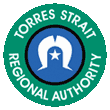Torres Strait Regional Authority
The Torres Strait Regional Authority (TSRA) is an Australian Government body established in 1994 to administer the Torres Strait Islands. It consists of 20 elected representatives. The primary function of the Authority is to strengthen the economic, social and cultural development of the peoples of the Torres Strait area.
 | |
| Regional authority overview | |
|---|---|
| Formed | 1 July 1994 |
| Jurisdiction | Torres Strait Islands |
| Parent department | Australian Government |
| Website | tsra |
The Torres Strait Territory Coalition was formed in 2010, with the aim of gaining official Territory status for the Torres Strait Islands. The plan would see the TSRA and local governments in the area abolished, but this has not come to pass.
The islands
The Torres Strait Islands lie to the north of Tropical Queensland's Cape York Peninsula and comprise 274 small islands, of which 17 are inhabited, located in Torres Strait which separates Australia and Papua New Guinea (PNG). Each island community elects a member to the Torres Strait Regional Authority.[1]
Thursday Island (Waiben) and Horn Island (Nurupai) are the most well-known of the Torres Strait Islands. Activities on the islands are quite traditional, with fishing being the major economic activity. To travel to the remote islands (other than Thursday and Horn Islands) permission is required from the Torres Strait Regional Authority.[2]
The five major island groups of the Torres Strait include:
- Northern Division (Boigu, Dauan, Saibai)
- Eastern Islands (Darnley, Murray, Stephen)
- Western Division (St. Pauls, Kubin, Badu, Mabuiag)
- Central Division (Yorke, Coconut, Warraber, Yam)
- Southern Division (TI and Inner Islands, NPA and Mainland Australia)
History of the TSRA
The authority was established in 1994, as a separate authority from the Aboriginal and Torres Strait Islander Commission (ATSIC), in order to deliver better services and programs to the Torres Strait Islander people living on the Islands.[3]
Together with the Island Co-ordinating Council (ICC), the TSRA has been active in implementing community based management strategies. The adoption of a Marine Strategy for the monitoring and management of dugong and turtle populations in the seas around the islands was undertaken in 1999.[4]
A 2001 evaluation found that employment and housing were the two areas of greatest need for improvement, being even worse than that of Torres Strait Islander people on the mainland and Australian Aboriginal people. However, in most other areas, such as health, cultural integrity and crime, the people on Islands fared better.[3]
The TSRA's 2001 Bamaga Accord,which proposed a new regional governance framework for the Islands, was an expression of the people's aspiration to have greater autonomy.[5]
In 2006, successful lobby by the authority and the ICC resulted in the granting of $300,000 from the Federal Government to study the risks of climate change on the six largest Torres Strait Islands.[6]
In 2010, after a nine-year legal battle, the TSRA made a successful native title claim to 40,000 km² of sea between Cape York Peninsula and Papua New Guinea.[7] This was the largest native title claim in Australia's history.[8]
The Torres Strait Territory Coalition was formed in 2010, with the aim of gaining official Territory status for the Torres Strait Islands. The plan would see the TSRA and local governments in the area abolished.[9][5]
Governance
The TSRA consists of 20 elected representatives, with its primary function being to strengthen the economic, social and cultural development of the peoples of the Torres Strait area.[10]
The TSRA board is led by a Chair of the Torres Strait Regional Authority and Deputy Chair. The current chair is Joseph Elu.[11] The day-to-day functions of the TSRA are carried out by an Administration Department led by a Chief Executive Officer, currently Wayne See Kee.[12]
Chairs of the Torres Strait Island Regional Authority
- 1 July 1994 – March 1997: Getano Lui, Jr. (b. 1952)
- March 1997 – 19 April 2000: John Abednego
- 19 April 2000 – May 2004: Terry Waia
- May 2004 – November 2012: John Toshie Kris
- November 2012 – Present: Joseph Elu
See also
- Torres Strait Island Region (a Queensland LGA)
- List of Australian government entities
References
- Kaye, Stuart B. (1997). The Torres Strait. Cambridge, Massachusetts: Kluwer Law International. p. 13. ISBN 90-411-0506-9.
- Queensland Destinations – The Torres Strait Islands. Tourism Queensland.
- Kelly, John (22 June 2001). "Evaluation of the Torres Strait Regional Authority" (PDF). Office of Evaluation and Audit. Archived from the original (PDF) on 4 March 2016.
- Nettheim, Garth; Gary D. Meyers; Donna Craig (2002). Indigenous Peoples and Governance Structures. Canberra: Aboriginal Studies Press. p. 386. ISBN 0-85575-379-X.
- "[Letter to PM Julia Gillard from Anna Bligh, Premier of Queensland]" (PDF). Retrieved 8 January 2020.
- "Going Under". The Sydney Morning Herald. 12 August 2006. Retrieved 29 June 2011.
- Nicole Butler (3 July 2010). "Islanders celebrate historic native title decision". ABC Online Indigenous. Australian Broadcasting Corporation. Retrieved 10 September 2010.
- "Historic native title decision looms". ABC News. Australian Broadcasting Corporation. 2 July 2010. Retrieved 28 June 2011.
- "TSRA, Councils to go under Territory plan". Torres News. 28 August 2010. Retrieved 10 September 2010.
- "Qld councils urged to cooperate". The Age. 26 July 2007. Retrieved 2 June 2008.
- "TSRA Board Elects Eight Portfolio Members". TSRA. 19 November 2012. Retrieved 18 December 2012.
- General Manager Profile Archived 9 March 2012 at the Wayback Machine. Torres Strait Regional Authority. Retrieved on 3 July 2011.
External links
- Torres Strait Regional Authority
- Australian Govt – TRSE website with links to resorts, island, links and details of Gab Titui Cultural Centre.
- Details of individual islands and local administration
- Flag of the TSRA and map
- Dauan Island Indigenous Knowledge Centre